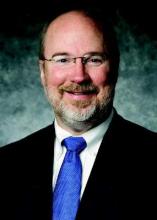AVENTURA, FLA. – Clinicians interested in providing naloxone for their patients at risk for an opioid overdose should consider the pros and cons of the different formulations, addiction medicine specialists say.
In addition, clinicians should become familiar with legislation affecting how naloxone can be prescribed to lay persons in their state, according to the specialists, who spoke at the annual meeting of the American Academy of Addiction Psychiatry.
During a workshop on expanding access to the opioid antagonist to patients at risk and their families to help prevent opioid overdoses, Dr. Eric D. Collins, physician-in-chief at Silver Hill Hospital, New Canaan, Conn., described naloxone as “an effective and generally safe intervention that requires minimal training” and can be administered by a layperson. “Any prescriber can provide naloxone to persons at risk of opioid overdose” and in some states, can provide naloxone to anyone at risk of witnessing an opioid overdose, he added.
Dr. Seddon R. Savage, director of the Dartmouth Center on Addiction Recovery and Education, Hanover, N.H., said that although providing naloxone is a late intervention, it saves lives. “So clearly, it is critical that we embrace that strategy,” she said.
Providing naloxone is among the current strategies used to address the misuse of prescription opioids and to reduce mortality and morbidity related to opioids. These strategies include the development of tamper-resistant products, public campaigns increasing awareness about the importance of locking up pain medications and disposing of them safely, drug take back programs, and pharmacy-based interventions.
Overdose death rates fall
To date, “good solid evidence for efficacy in reducing mortality and opioid overdoses only exists” for maintenance therapy of opioid dependence and naloxone distribution, said Dr. Savage, who also is medical director of the chronic pain and addiction program at Silver Hill Hospital. She cited a 2013 study that found a significant reduction in opioid overdose deaths rate after a program that provided education about overdoses and nasal naloxone kits to potential bystanders (users, families, and friends) was implemented in 19 communities in Massachusetts with high overdose rates. Training included 10-60 minutes of training in recognizing and intervening in an overdose (BMJ 2013; 346:f174).
For pain medicine specialists, Dr. Savage said, “it is reasonable to consider” providing naloxone to patients at risk for overuse tied to unmet pain needs, accidental overuse, or self-treatment of other symptoms; as well as those with history of recreational drug use or addiction. Primary care clinicians can target their patients being treated with opioids for pain and those with known or a suspected addiction to opioids. Addiction medicine specialists can consider prescribing naloxone to their patients with opioid addiction on or off opioid agonist therapy (OAT), such as buprenorphine.
However, challenges prevail in prescribing naloxone, which include wide variations in naloxone legislation and Good Samaritan laws in states, resources needed to train lay people to administer naloxone, and recent increases in the cost of intranasal naloxone. The latter is the most widely used form of the drug to treat overdoses, said Dr. Savage, who also is affiliated with Dartmouth Medical School in Hanover.
Familiarity with laws advised
Dr. Savage advised clinicians to become familiar with the policies regarding naloxone prescribing and Good Samaritan laws in their jurisdictions. Legislation that exists in some states but not others include protection from possession of controlled substance and paraphernalia (in 22 states and the District of Columbia [D.C.] as of August 2014), protection from criminal liability for lay administration of naloxone (23 states and D.C.), protection from civil liability for lay administration (20 states and D.C.) and protection of prescribers from criminal liability (13 states). In 24 states, third party prescribing is allowed.
Naloxone – which binds to opioid receptors and in patients on opioids, thereby reversing the effects of opioids, including respiratory depression – can precipitate opioid withdrawal symptoms in some patients, said Dr. Collins, who also is affiliated with Columbia University in New York. He referred to a 2004 study that found that the most common adverse events after naloxone was used to treated a suspected opioid overdose outside of the hospital were confusion ( 32%) and headache (22%), nausea and vomiting (9%), and aggressiveness (8%), but serious complications were rare (Eur. J. Emerg. Med. 2004;11:19-23). Seizures were reported in 4% and tachycardia was reported in 6%. Dr. Collins said he has never seen a case of allergy to naloxone, the only contraindication to the drug.
Since aggressiveness might be associated with withdrawal, Dr. Savage said training for naloxone providers often includes how to manage a combative person. The risk of tachycardia has been raised as a concern, particularly in situations where law enforcement personnel who are not medically trained are delivering naloxone, but those patients are transported to medical facilities, she pointed out.



